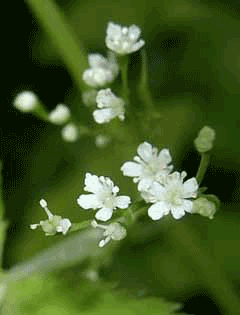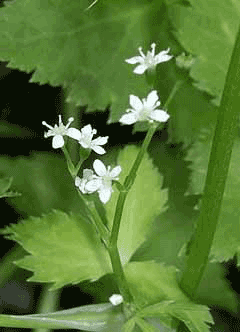 |
|
http://commons.wikimedia.org/wiki/User:KENPEI |
 |
| http://commons.wikimedia.org/wiki/User:KENPEI |
Translate this page:
Summary
Physical Characteristics

 Cryptotaenia japonica is an evergreen Perennial growing to 1 m (3ft 3in) by 0.6 m (2ft).
Cryptotaenia japonica is an evergreen Perennial growing to 1 m (3ft 3in) by 0.6 m (2ft).
See above for USDA hardiness. It is hardy to UK zone 5. It is in leaf all year, in flower from July to August, and the seeds ripen from August to September. The species is hermaphrodite (has both male and female organs) and is pollinated by Insects. The plant is self-fertile.
Suitable for: light (sandy), medium (loamy) and heavy (clay) soils. Suitable pH: mildly acid, neutral and basic (mildly alkaline) soils. It can grow in full shade (deep woodland) semi-shade (light woodland) or no shade. It prefers moist soil.
UK Hardiness Map
US Hardiness Map
Synonyms
C. canadense japonica.
Plant Habitats
Woodland Garden Dappled Shade; Shady Edge; not Deep Shade;
Edible Uses
Edible Parts: Leaves Root Stem
Edible Uses: Condiment
Leaves and stems - raw or cooked[2, 52, 116]. Used as a flavouring with a parsley-like flavour if you let your imagination run away with you[K]. Seedlings and young leaves can be used in salads[206]. When cooking, the leaves should not be cooked for more than a couple of minutes or the flavour is destroyed[206]. The leaves contain about 2.3% protein, 0.23% fat, 4.4% carbohydrate, 2.1% ash[179]. Root - raw or cooked[2, 52, 116, 183]. Blanched stem - a celery substitute[2, 116]. The seed is used as a seasoning.
References More on Edible Uses
Medicinal Uses
Plants For A Future can not take any responsibility for any adverse effects from the use of plants. Always seek advice from a professional before using a plant medicinally.
Febrifuge Tonic Women's complaints
Women's complaints. Used in the treatment of haemorrhages, colds, fevers etc[178]. Used as a tonic for strengthening the body[266].
References More on Medicinal Uses
The Bookshop: Edible Plant Books
Our Latest books on Perennial Plants For Food Forests and Permaculture Gardens in paperback or digital formats.

Edible Tropical Plants
Food Forest Plants for Hotter Conditions: 250+ Plants For Tropical Food Forests & Permaculture Gardens.
More

Edible Temperate Plants
Plants for Your Food Forest: 500 Plants for Temperate Food Forests & Permaculture Gardens.
More

More Books
PFAF have eight books available in paperback and digital formats. Browse the shop for more information.
Shop Now
Other Uses
References More on Other Uses
Cultivation details
Succeeds in most soils, preferring a moist shady position under trees where it often self-sows[52]. The leaves tend to turn yellow when plants are grown in full sun[206]. This species is not winter-hardy in all areas of Britain, though plants can tolerate short periods at temperatures down to -10°c[206]. Mitsuba is commonly cultivated as a vegetable in Japan, there are some named varieties[183]. It is usually grown as an annual[206]. It is closely allied to C. canadensis, and is considered to be no more than a synonym of that species by some botanists[200]. This plant is adored by slugs and snails and must be protected when small or when new growth is emerging in the spring[K]. For polyculture design as well as the above-ground architecture (form - tree, shrub etc. and size shown above) information on the habit and root pattern is also useful and given here if available. The plant growth habit is a clumper with limited spread [1-2]. The root pattern is flat with shallow roots forming a plate near the soil surface [1-2]. The root pattern is a tap root similar to a carrot going directly down [1-2].
References Carbon Farming Information and Carbon Sequestration Information
Temperature Converter
Type a value in the Celsius field to convert the value to Fahrenheit:
Fahrenheit:
The PFAF Bookshop
Plants For A Future have a number of books available in paperback and digital form. Book titles include Edible Plants, Edible Perennials, Edible Trees,Edible Shrubs, Woodland Gardening, and Temperate Food Forest Plants. Our new book is Food Forest Plants For Hotter Conditions (Tropical and Sub-Tropical).
Shop Now
Plant Propagation
Seed - sow April in a greenhouse. Germination is usually rapid, prick out the seedlings into individual pots when they are large enough to handle and plant them out in early summer. The ideal temperature for sowing is about 25°c, though seed does germinate at higher and lower temperatures[206]. Seed can also be sown in early autumn[206]. Division in spring or autumn.
Other Names
If available other names are mentioned here
Native Range
TEMPERATE ASIA: Anhui Sheng, China, Fujian Sheng, Gansu Sheng, Guangdong Sheng, Guangxi Zhuangzu Zizhiqu, Guizhou Sheng, Hebei Sheng, Hokkaidô, Honshu, Hubei Sheng, Hunan Sheng, Japan, Jiangsu Sheng, Jiangxi Sheng, Korea, Kurile Islands (south), Kyushu, Ryukyu Islands, Shanxi Sheng, Sichuan Sheng, Taiwan, Yunnan Sheng,Russian Federation.
Weed Potential
Right plant wrong place. We are currently updating this section.
Please note that a plant may be invasive in one area but may not in your area so it's worth checking.
Conservation Status
IUCN Red List of Threatened Plants Status :

Growth: S = slow M = medium F = fast. Soil: L = light (sandy) M = medium H = heavy (clay). pH: A = acid N = neutral B = basic (alkaline). Shade: F = full shade S = semi-shade N = no shade. Moisture: D = dry M = Moist We = wet Wa = water.
Now available:
Food Forest Plants for Mediterranean Conditions
350+ Perennial Plants For Mediterranean and Drier Food Forests and Permaculture Gardens.
[Paperback and eBook]
This is the third in Plants For A Future's series of plant guides for food forests tailored to
specific climate zones. Following volumes on temperate and tropical ecosystems, this book focuses
on species suited to Mediterranean conditions—regions with hot, dry summers and cool, wet winters,
often facing the added challenge of climate change.
Read More
Expert comment
Author
Hassk.
Botanical References
58275
Links / References
For a list of references used on this page please go here
Readers comment